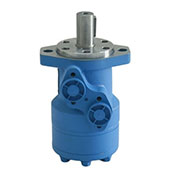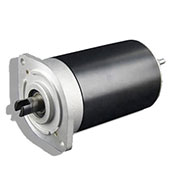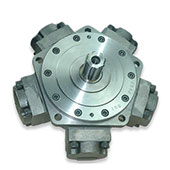Hydraulic Motor Buying Guide
A hydraulic motor is a mechanical actuator that converts hydraulic pressure and flows into torque and angular displacement (rotation). Hydraulic motors serve the electric power, construction, water conservancy, transportation, ships, automobiles, aerospace and military field. Hydraulic systems are widely used in papermaking, textile, plastics, rubber and other light industries. It also plays an important role in heavy industry, like mining, petroleum, metallurgy and pressure processing.
When purchasing a hydraulic motor, the main basis is requirements for the hydraulic system, such as torque, speed, working pressure, displacement, shape and connection size, volumetric efficiency, total efficiency, quality, price, supply, convenience of use and maintenance.
Advantages of hydraulic motors
- High power-weight ratio: The ratio of the energy transmitted by the hydraulic motor to its own weight is very small compared to other transmission methods.
- Good starting performance: It is easy to obtain larger force and torque. Its starting torque is large.
- Easy to control: It can start and stop quickly and frequently, forward and reverse, and has little impact on current;
- Automatic control of overload accidents.
- Strong environmental adaptability: It is adaptable to temperature, dust, water-rich rings, etc.
ATO's Hydraulic Motor Types
According to its structure type, hydraulic motors can be divided into gear, vane, piston hydraulic motor and other types. ATO has a wild range of hydraulic motors to meet your buying requirements. Each has its specific purpose and applicable working conditions. This time, some of ATO's bestselling hydraulic motors are presented below for you to purchase.
 The orbital motor is a hydraulic motor of internal meshing cycloid gear type. The ring gear is fixedly connected with the housing, and the oil entering from the oil port pushes the rotor to revolve around a center point. This slow-rotating rotor drives the output through a splined shaft called a orbital motor. It is mainly used in the slewing mechanism of various machinery such as agriculture, fishery, light industry, lifting and transportation, mining, and construction machinery. Our website have 50 to 395 cc/rev displacement orbital motors on sale for you to choose from.
The orbital motor is a hydraulic motor of internal meshing cycloid gear type. The ring gear is fixedly connected with the housing, and the oil entering from the oil port pushes the rotor to revolve around a center point. This slow-rotating rotor drives the output through a splined shaft called a orbital motor. It is mainly used in the slewing mechanism of various machinery such as agriculture, fishery, light industry, lifting and transportation, mining, and construction machinery. Our website have 50 to 395 cc/rev displacement orbital motors on sale for you to choose from.
 Hydraulic pump is a hydraulic component that provides pressurized liquid for hydraulic transmission. Its function is to convert the mechanical energy of power machines (such as electric motors and internal combustion engines) into liquid pressure energy. The working principle of the hydraulic pump is that the movement changes the volume of the pump cavity, thereby compressing the fluid so that the fluid has pressure energy. If you're interested in this product, we also have hydraulic pump of different power sizes on sale for you to buy.
Hydraulic pump is a hydraulic component that provides pressurized liquid for hydraulic transmission. Its function is to convert the mechanical energy of power machines (such as electric motors and internal combustion engines) into liquid pressure energy. The working principle of the hydraulic pump is that the movement changes the volume of the pump cavity, thereby compressing the fluid so that the fluid has pressure energy. If you're interested in this product, we also have hydraulic pump of different power sizes on sale for you to buy.
 The radial piston motor is a low-speed and high-torque motor. Radial piston motor have good reversing characteristics for quiet motor operation. Its main features are large output torque and good low-speed stability (stable operation below 10r/min, and some can be as low as 0.5r/min), so it can work directly with Institutional connections. Radial piston motors are usually divided into two types, namely single-acting swing cylinder type and multi-acting inner curve type. ATO can provide you with radial piston motors of various powers to purchase.
The radial piston motor is a low-speed and high-torque motor. Radial piston motor have good reversing characteristics for quiet motor operation. Its main features are large output torque and good low-speed stability (stable operation below 10r/min, and some can be as low as 0.5r/min), so it can work directly with Institutional connections. Radial piston motors are usually divided into two types, namely single-acting swing cylinder type and multi-acting inner curve type. ATO can provide you with radial piston motors of various powers to purchase.
After determining the type of hydraulic motor, several specifications that meet the needs can be selected according to the required rotational speed and torque. First, the corresponding pressure drop, flow rate and efficiency are calculated through the characteristic curves of various specifications, and comprehensive analysis could be carried out.
If the original cost is the most important, you should choose a motor that not only meets the torque requirements, but also makes the system flow smaller and lower pressure, so that the hydraulic source, control valve and pipeline specifications can be smaller.
If the running cost is the most important, the motor with high total efficiency should be selected.
If the working life is the most important, the motor with the smallest pressure drop should be selected.
Here, various motor types are available for your particular use, If you want to know more, please visit ATO.com.

